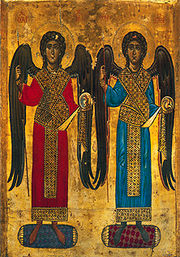Angel
_-_Song_of_the_Angels_(1881).jpg)
Angels are messengers of God in the Hebrew Bible (translating מלאך), the New Testament and the Quran. The term "angel" has also been expanded to various notions of "spiritual beings" found in many other religious traditions. Other roles of angels include protecting and guiding human beings, and carrying out God's tasks.
The theological study of angels is known as angelology. In art, angels are often depicted with wings, ultimately reflecting the descriptions in the Hebrew Bible, such as the chayot in Ezekiel's Merkabah vision or the Seraphim of Isaiah.
Contents |
Etymology

The word angel in English is a fusion of the Old English word engel (with a hard g) and the Old French angele. Both derive from the Latin angelus which in turn is the romanization of the ancient Greek ἄγγελος (angelos), "messenger".[1] The earliest form of the word is the Mycenaean a-ke-ro attested in Linear B syllabic script.[2][3]
Judaism
The Bible uses the terms מלאך אלהים (mal'akh Elohim; messenger of God), מלאך יהוה (mal'akh Adonai; messenger of the Lord), בני אלהים (b'nai Elohim; sons of God) and הקודשים (ha-qodeshim; the holy ones) to refer to beings traditionally interpreted as angels. Other terms are used in later texts, such as העליונים (ha'elyoneem; the upper ones). Daniel is the first biblical figure to refer to individual angels by name.[4]
In post-Biblical Judaism, certain angels came to take on a particular significance and developed unique personalities and roles. Though these archangels were believed to have rank amongst the heavenly host, no systematic hierarchy ever developed. Metatron is considered one of the highest of the angels in Merkabah and Kabbalist mysticism and often serves as a scribe. He is briefly mentioned in the Talmud,[5] and figures prominently in Merkabah mystical texts. Michael, who serves as a warrior and advocate for Israel (Daniel 10:13) is looked upon particularly fondly. Gabriel is mentioned in the Book of Daniel (Daniel 8:15–17), the Book of Tobit, and briefly in the Talmud,[6] as well as many Merkabah mystical texts. There is no evidence in Judaism for the worship of angels, but evidence for the invocation and sometimes even conjuration of angels.[7]
Medieval Jewish philosopher Maimonides explained his view of angels in his Guide for the Perplexed II:4 and II:6:
...This leads Aristotle in turn to the demonstrated fact that God, glory and majesty to Him, does not do things by direct contact. God burns things by means of fire; fire is moved by the motion of the sphere; the sphere is moved by means of a disembodied intellect, these intellects being the 'angels which are near to Him', through whose mediation the spheres [planets] move... thus totally disembodied minds exist which emanate from God and are the intermediaries between God and all the bodies [objects] here in this world.
– Guide for the Perplexed II:4, Maimonides
According to Kabalah, there are four worlds and our world is the last world: the world of action (Assiyah). Angels exist in the worlds above as a 'task' of God. They are an extension of God to produce effects in this world. After an angel has completed its task, it ceases to exist. The angel is in effect the task. This is derived from the book of Genesis when Abraham meets with three angels and Lot meets with two. The task of one of the angels was to inform Abraham of his coming child. The other two were to save Lot and to destroy Sodom and Gomorrah.[8]
Famous angels and their tasks:[9]
- Malachim (translation: messengers), general word for angel
- Michael (translation: who is like God), performs God's kindness
- Gabriel (translation: the strength of God), performs acts of justice and power
- Raphael (translation: God Heals), God's healing force
- Uriel (translation: God is my light), leads us to destiny
- Seraphim (translation: the burning ones), protects the gates to the Garden of Eden
- Malach HaMavet (translation: the angel of death)
- HaSatan (translation: the prosecutor), brings people's sins before them in the heavenly court
- Chayot HaKodesh (translation: the holy beasts)
- Ophanim (translation: arbits) Astrological Influence
- HaMerkavah (translation: the chariot), transports God's glory
Christianity
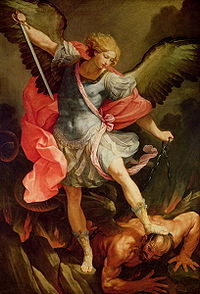
Early Christians inherited Jewish understandings of angels. In the early stage, the Christian concept of an angel characterized the angel as a messenger of God. Angels are creatures of good, spirits of love, and messengers of the savior Jesus Christ. Later came identification of individual angelic messengers: Gabriel, Michael, Raphael, Uriel, and Lucifer. Then, in the space of little more than two centuries (from the third to the fifth) the image of angels took on definite characteristics both in theology and in art.[10]
By the late fourth century, the Church Fathers agreed that there were different categories of angels, with appropriate missions and activities assigned to them. Some theologians had proposed that Jesus was not divine but on the level of immaterial beings subordinate to the Trinity. The resolution of this Trinitarian dispute included the development of doctrine about angels.[11]
The angels are represented throughout the Christian Bible as a body of spiritual beings intermediate between God and men: "You have made him (man) a little less than the angels..." (Psalms 8:4,5). Some Christians believe that angels are created beings, and use the following passage as evidence: "praise ye Him, all His angels: praise ye Him, all His hosts... for He spoke and they were made. He commanded and they were created..." (Psalms 148:2-5; Colossians 1:16). The Fourth Lateran Council (1215) declared that the angels were created beings. The Council's decree Firmiter credimus (issued against the Albigenses) declared both that angels were created and that men were created after them. The First Vatican Council (1869) repeated this declaration in Dei Filius, the "Dogmatic constitution on the Catholic faith". Of note is that the bible describes the function of angels as "messengers" and does not indicate when the creation of angels occurred.[12][13]
Many Christians regard angels as asexual and not belonging to either gender as they interpret Matthew 22:30 in this way. Angels are on the other hand usually described as looking like male human beings. Their names are also masculine. And although angels have greater knowledge than men, they are not omniscient, as Matthew 24:36 points out.[14] Another view is that angels are sent into this world for testing, in the form of humans.[15]
Interaction with angels
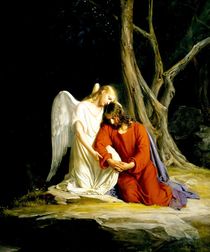
The New Testament includes a number of interactions and conversations between angels and humans. For instance, three separate cases of angelic interaction deal with the births of John the Baptist and Jesus Christ. In Luke 1:11, an angel appears to Zechariah to inform him that he will have a child despite his old age, thus proclaiming the birth of John the Baptist[16] And in Luke 1:26 the archangel Gabriel visits the Virgin Mary in the Annunciation to foretell the birth of Jesus Christ.[17] Angels then proclaim the birth of Jesus in the Adoration of the shepherds in Luke 2:10.[18] Angels also appear later in the New Testament. In Luke 22:43 an angel comforts Jesus Christ during the Agony in the Garden.[19] In Matthew 28:5 an angel speaks at the empty tomb, following the Resurrection of Jesus and the rolling back of the stone by angels.[20] Hebrews 13:2 reminds the reader that they may "entertain angels unaware".[21]
Since the completion of the New Testament, the Christian tradition has continued to include a number of reported interactions with angels. For instance, in 1851 Pope Pius IX approved the Chaplet of Saint Michael based on the 1751 private revelation from archangel Michael to the Carmelite nun Antonia d'Astonac.[22] And Pope John Paul II emphasized the role of angels in Catholic teachings in his 1986 address titled "Angels Participate In History Of Salvation", in which he suggested that modern mentality should come to see the importance of angels.[23]
As recently as the 20th century, visionaries and mystics have reported interactions with, and indeed dictations from, angels. For instance, the bed-ridden Italian writer and mystic Maria Valtorta wrote The Book of Azariah based on "dictations" that she directly attributed to her guardian angel Azariah, discussing the Roman Missal used for Sunday Mass in 1946 and 1947.[24] 21st century mystic and medium Danielle Egnew is referenced in Steve Barney’s book The Sacred and the Profane[25] as a prominent example of modern day communication with angels, during which Egnew reports channeled angelic messages of individual assistance[26] as well as future world events such as 2012.[27]
Iconography
The earliest known Christian image of an angel, in the Cubicolo dell'Annunziazione in the Catacomb of Priscilla, which is dated to the middle of the third century, is without wings. Representations of angels on sarcophagi and on objects such as lamps and reliquaries of that period also show them without wings,[28] as for example the angel in the Sacrifice of Isaac scene in the Sarcophagus of Junius Bassus. However, the side view photos of the Sarcophagus show winged angelic figures.
The earliest known representation of angels with wings is on what is called the Prince's Sarcophagus, discovered at Sarigüzel, near Istanbul, in the 1930s, and attributed to the time of Theodosius I (379-395).[29]
Saint John Chrysostom explained the significance of angels' wings: "They manifest a nature's sublimity. That is why Gabriel is represented with wings. Not that angels have wings, but that you may know that they leave the heights and the most elevated dwelling to approach human nature. Accordingly, the wings attributed to these powers have no other meaning than to indicate the sublimity of their nature."[30]

From then on, though of course with some exceptions, Christian art represented angels with wings, as in the cycle of mosaics in the Basilica of Saint Mary Major (432–440).[31] Four- and six-winged angels, often with only their face and wings showing, drawn from the higher grades of angels, especially cherubim and seraphim, are derived from Persian art, and are usually shown only in heavenly contexts, as opposed to performing tasks on earth. They often appear in the pendentives of domes or semi-domes of churches.
Angels, especially the Archangel Michael, who were depicted as military-style agents of God came to shown wearing Late Antique military uniform. This could be either the normal military dress, with a tunic to about the knees, armour breastplate and pteruges, but also often the specific dress of the bodyguard of the Byzantine Emperor, with a long tunic and the loros, a long gold and jewelled pallium restricted to the Imperial family and their closest guards. The basic military dress is still worn in pictures into the Baroque period and beyond in the West (see Reni picture above), and up to the present day in Eastern Orthodox icons. Other angels came to be conventionally depicted in long robes, and in the later Middle Ages they often wear the vestments of a deacon, a cope over a dalmatic, especially Gabriel in Annunciation scenes—for example the Annunciation in Washington by Jan van Eyck.
Latter Day Saints
The Latter Day Saint movement (generally called "Mormons") view angels as the messengers of God. They are sent to mankind to deliver messages, minister to humanity, teach doctrines of salvation, call mankind to repentance, give priesthood keys, save individuals in perilous times, and guide humankind.[32]
Latter Day Saints believe that angels are former humans or the spirits of humans yet to be born,[33] and accordingly Joseph Smith taught that "there are no angels who minister to this earth but those that do belong or have belonged to it."[34] As such, Latter Day Saints also believe that Adam (the first man) is now the archangel Michael,[35][36] and that Gabriel lived on the earth as Noah.[33] Likewise the Angel Moroni first lived in a pre-Columbian American civilization as the 5th-century prophet-warrior named Moroni.
Joseph Smith, Jr. described his first angelic encounter thus:[37]
While I was thus in the act of calling upon God, I discovered a light appearing in my room, which continued to increase until the room was lighter than at noonday, when immediately a personage appeared at my bedside, standing in the air, for his feet did not touch the floor.
He had on a loose robe of most exquisite whiteness. It was a whiteness beyond anything earthly I had ever seen; nor do I believe that any earthly thing could be made to appear so exceedingly white and brilliant....
Not only was his robe exceedingly white, but his whole person was glorious beyond description, and his countenance truly like lightning. The room was exceedingly light, but not so very bright as immediately around his person. When I first looked upon him, I was afraid; but the fear soon left me.
Most angelic visitations in the early Latter Day Saint movement were witnessed by Joseph Smith and Oliver Cowdery, who both claimed (prior to the establishment of the Church) to have been visited by the prophet Moroni, the Book of Mormon prophet Nephi, John the Baptist, and the Apostles Peter, James, and John. Later, at the dedication of the Kirtland Temple, Smith and Cowdery claimed to have been visited by Jesus, and subsequently by Moses, Elias, and Elijah.[38]
People who claimed to have received a visit by an angel include the other two of the three witnesses: David Whitmer and Martin Harris. Many other Latter Day Saints, both in the early and modern church, have claimed to have seen angels, though Smith posited that, except in extenuating circumstances such as the restoration, mortals teach mortals, spirits teach spirits and resurrected beings teach other resurrected beings.[39]
New Church (Swedenborgian)
The Christian (Swedish) writer Emanuel Swedenborg (1688–1772) wrote in his book Conjugal Love that a soul of a man and a soul of a woman who are (happily) united by marriage enter heaven and become an angel. This could be a married couple on earth or a couple that met after their earthly deaths.
Islam
Islam is clear on the nature of angels in that they are messengers of God. They have no free will, and can do only what God orders them to do. Angels mentioned in the Quran and Hadith include Gabriel (the angel of revelation), Michael (Brings food), Israfel (The horn Blower; signals of the end), Izraail/Azrael ( the angel of death.), Raqib (Writes good doings), Aatid (Writes bad doings), Maalik (Guardian of Hell), Ridwan (Guardian of Heaven), Munkar and Nakir (Interrogater afterlife).
Angels can take on different forms. The Islamic prophet Muhammad, speaking of the magnitude of the angel Gabriel, has said that his wings spanned from the Eastern to the Western horizon. Also, in Islamic tradition, angels used to take on human form.[40]
The following is a Quranic verse that mentions the meeting of an angel with Mary, mother of Jesus: Surah Aal ‘Imran Chapter 3 verse 45
Behold! The angels said: O Mary! God giveth thee glad tidings of a Word from Him: his name is the Christ Eisa the son of Mariam, held in honour in this world and the Hereafter and of (the company of) those Nearest to God.
– [Al-Qur’an 3:45]
Islamic mysticism
The 13th century Persian Islamic Sufi mystic poet Jalal al-Din Muhammad Rumi wrote in his poem Masnavi:
I died as inanimate matter and arose a plant,
I died as a plant and rose again an animal.
I died as an animal and arose a man.
Why then should I fear to become less by dying?
I shall die once again as a man
To rise an angel perfect from head to foot!
Again when I suffer dissolution as an angel,
I shall become what passes the conception of man!
Let me then become non-existent, for non-existence
Sings to me in organ tones, {'To him shall we return.'}[41]
Bahá'í Faith
Bahá'u'lláh, the founder of the Bahá'í Faith, referred to angels as people who through the love of God have consumed all human limitations and have been endowed with spiritual attributes.[42]
`Abdu'l-Bahá, Bahá'u'lláh's son, defined angels as "those holy souls who have severed attachment to the earthly world, who are free from the fetters of self and passion and who have attached their hearts to the divine realm and the merciful kingdom".[43]
Furthermore, he said that people can be angels in this world:
"Ye are the angels, if your feet be firm, your spirits rejoiced, your secret thoughts pure, your eyes consoled, your ears opened, your breasts dilated with joy, and your souls gladdened, and if you arise to assist the Covenant, to resist dissension and to be attracted to the Effulgence!"[44]
Non-Abrahamic traditions
"Angel" is sometimes used as a translation of related concepts in non-Abrahamic traditions.
Zoroastrianism
In Zoroastrianism there are different angel-like figures. For example, each person has one guardian angel, called Fravashi. They patronize human beings and other creatures, and also manifest God’s energy. The Amesha Spentas have often been regarded as angels, although they don't convey messages,[45] but are rather emanations of Ahura Mazda ("Wise Lord", God); they initially appear in an abstract fashion and then later became personalized, associated with diverse aspects of the divine creation.[46]
Indian religions
In Hinduism, the term deva is sometimes translated as "angel" (besides "god" or "deity").But essentially deva is not an angel. Instead deva is the embodiment of a natural element with explicit manifestation in physical realms.[47] Angels are usually translated as Gandharvas and apsaras and also as cārana from Sanskrit. See: Srimad Bhagavatam 3.10.28-29 [1]
Sikhism
In Sikhism, the references to angelic or divine deities is often objected as the religion focuses on the liberation of the soul and ultimately joining with Waheguru. However, in early scriptures written by Guru Nanak Dev Ji indicate specific heavenly deities to help in the judgment of the soul.
Azrael (as Azraa-eel) is named as the angel of death in the Guru Granth Sahib, the holy scripture and the final Guru of the Sikhs.[48]
In So Dar and Raag Asa Sat Guru Nanak mentions clearly two beings Chitar and Gupat who record the deeds of men. These beings are Angels assigned with this Divine task by the Creator. Chitar records the deeds that are visible to all and Gupat records that which is hidden in thought or secret action. Their names themselves allude to the tasks which the All Mighty has bestowed upon them. The celestial beings are often seen at the gates of heaven, dressed in the most adorned and decorated gowns, holding the records on the actions and feelings of the soul in the line for judgement.[49][50]
New religious movements and occultism
Theosophy
In the teachings of Theosophy, Devas are regarded as living either in the atmospheres of the planets of the solar system (Planetary Angels) or inside the Sun (Solar Angels) (presumably other planetary systems and stars have their own angels) and they help to guide the operation of the processes of nature such as the process of evolution and the growth of plants; their appearance is reputedly like colored flames about the size of a human. It is believed by Theosophists that devas can be observed when the third eye is activated. Some (but not most) devas originally incarnated as human beings. [51]
It is believed by Theosophists that nature spirits, elementals (gnomes, undines, sylphs, and salamanders), and fairies can be also be observed when the third eye is activated.[52] It is maintained by Theosophists that these less evolutionarily developed beings have never been previously incarnated as humans; they are regarded as being on a separate line of spiritual evolution called the “deva evolution”; eventually, as their souls advance as they reincarnate, it is believed they will incarnate as devas.[53]
It is asserted by Theosophists that all of the above mentioned beings possess etheric bodies that are composed of etheric matter, a type of matter finer and more pure that is composed of smaller particles than ordinary physical plane matter.[53]
Contemporary belief in angels
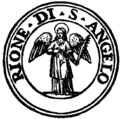
A 2002 study based on interviews with 350 people, mainly in the UK, who said they have had an experience of an angel, describes several types of such experiences: visions, sometimes with multiple witnesses present; auditions, e.g. to convey a warning; a sense of being touched, pushed, or lifted, typically to avert a dangerous situation; and pleasant fragrance, generally in the context of somebody's death. In the visual experiences, the angels described appear in various forms, either the "classical" one (human countenance with wings), in the form of extraordinarily beautiful or radiant human beings, or as beings of light.[54]
In the US, a 2008 survey by Baylor University's Institute for Studies of Religion, published by T.I.M.E. Magazine,[55][56] which polled 1,700 respondents, found that 55 percent of Americans, including one in five of those who say they are not religious, believe that they have been protected by a guardian angel during their life. An August 2007 Pew poll found that 68 percent of Americans believe that "angels and demons are active in the world",[57] and according to four different polls conducted in 2009, a greater percentage of Americans believe in angels (55%) than those who believe in global warming (36%).[58][59]
According to the Gallup Youth Survey, in a Teen Belief in the Supernatural poll in 1994, 76% of 508 teenagers (aged 13-17) believe in angels, a greater percentage than those whom believed in astrology, ESP, ghosts, witchcraft, clairvoyance, bigfoot, and vampires. In 1978, 64% of American young people believed in angels; in 1984, 69% of teenagers believed in angels; and by 1994, that number grew to 76%, while belief in other supernatural concepts, such as the Loch Ness monster and ESP, have declined. In 1992, 80% of 502 surveyed teenage girls believe in angels, and 81% of Catholic teens and 82% of regular church attendees harbored beliefs in angels.[60]
In Canada, a 2008 survey of over 1000 Canadians found 67 percent believe in angels.[61]
See also
- Archangel
- Celestial (Dungeons & Dragons)
- Christian angelic hierarchy
- Fallen angel
- Watcher or Grigori
- Jewish angelic hierarchy
- Nephilim
- Shoulder angel
- Apsara
- Gandharva
- Carana
Notes
- ↑ ἄγγελος, Henry George Liddell, Robert Scott, A Greek-English Lexicon, on Perseus project
- ↑ a-ke-ro, Palaeolexicon (Word study tool of ancient languages)
- ↑ Mycenaean (Linear b) - English Glossaryy
- ↑ Jewish Encyclopedia, accessed Feb. 15, 2008
- ↑ Sanhedrin 38b and Avodah Zerah 3b.
- ↑ cf. Sanhedrin 95b
- ↑ Angels, Jewish Encyclopedia, 1914
- ↑ The Jewish Encyclopedia Retrieved January 31, 2010
- ↑ The Jewish Encyclopedia, retrieved January 31, 2010
- ↑ Proverbio(2007), pp. 25-38; cf. summary in Libreria Hoepli
- ↑ Proverbio(2007), pp. 29-38; cf. summary in Libreria Hoepli and review in La Civiltà Cattolica, 3795-3796 (2–16 August 2008), pp. 327-328.
- ↑ http://www.christiananswers.net/q-acb/acb-t005.html#2
- ↑ http://www.apologeticspress.org/articles/468
- ↑ BibleGateway, Matthew 24:36
- ↑ Angels sent into this world for testing
- ↑ BibleGateway, Luke 1:11
- ↑ BibleGateway, Luke 1:26
- ↑ BibleGateway, Luke 2:10
- ↑ BibleGateway, Luke 22:43
- ↑ BibleGateway, Matthew 28:5
- ↑ BibleGateway, Hebrews 13:2
- ↑ Ann Ball, 2003 Encyclopedia of Catholic Devotions and Practices ISBN 087973910X page 123
- ↑ Angels Participate In History Of Salvation, Vatican website
- ↑ Maria Valtorta 1972, The Book of Azariah ISBN 8879870130
- ↑ Steve Barney 2009, The Sacred and the Profane ISBN: 1615793690 page 361
- ↑ Spirit Guide Intercession, Danielle Egnew spiritual website
- ↑ The Sunday Indian Lifestyle section, The Sunday Indian website
- ↑ Proverbio(2007), pp. 81-89; cf. review in La Civiltà Cattolica, 3795-3796 (2–16 August 2008), pp. 327-328.
- ↑ Proverbio(2007) p. 66
- ↑ Proverbio(2007) p. 34
- ↑ Proverbio(2007), pp. 90–95; cf. review in La Civiltà Cattolica, 3795–3796 (2–16 August 2008), pp. 327–328.
- ↑ "God's messengers, those individuals whom he sends (often from his personal presence in the eternal worlds), to deliver his messages (Luke 1:11–38); to minister to his children (Acts 10:1–8, Acts 10:30–32); to teach them the doctrines of salvation (Mosiah 3); to call them to repentance (Moro. 7:31); to give them priesthood and keys (D. & C. 13; 128:20–21); to save them in perilous circumstances (Nehemiah 3:29–31; Daniel 6:22); to guide them in the performance of his work (Genesis 24:7); to gather his elect in the last days (Matthew 24:31); to perform all needful things relative to his work (Moro. 7:29–33)—such messengers are called angels.", McConkie, Bruce R.. "Angels". Angels. LightPlanet. http://www.lightplanet.com/mormons/basic/doctrines/angels_eom.htm#brm. Retrieved 2008-10-27;
^ Deseret (1966) p.36. - ↑ 33.0 33.1 LDS Bible Dictionary-Angels
- ↑ D&C 130:5
- ↑ "Chapter 6: The Fall of Adam and Eve," Gospel Principles, 31, see also the entry for Adam in “Glossary,” Gospel Principles, 376
- ↑ D&C 107:24
- ↑ Joseph Smith History 1:30-33
- ↑ D&C 110
- ↑ The Fulness of Times
- ↑ http://www.bayyinat.org.uk/jibreel.htm
- ↑ Masnavi
- ↑ Smith, Peter (2000). "angels". A concise encyclopedia of the Bahá'í Faith. Oxford: Oneworld Publications. pp. 38–39. ISBN 1-85168-184-1.
- ↑ 'Abdu'l-Bahá (1976). "THE SPIRITUAL ASSEMBLY". US Bahá’í Publishing Trust. http://reference.bahai.org/en/t/c/BWF/bwf-122.html. Retrieved 2007-06-24.
- ↑ 'Abdu'l-Bahá. "Ye Are The Angels". bcca.org. http://www.bcca.org/ref/books/bwf/0811yearetheangels.html. Retrieved 2007-06-24.
- ↑ Lewis, James R., Oliver, Evelyn Dorothy, Sisung Kelle S. (Editor) (1996), Angels A to Z, Entry: Zoroastrianism, pp. 425-427, Visible Ink Press, ISBN 0-7876-0652-9
- ↑ Darmesteter, James (1880)(translator), The Zend Avesta, Part I: Sacred Books of the East, Vol. 4, pp. lx-lxxii, Oxford University Press, 1880, at sacred-texts.com
- ↑ Encyclopaedia Britannica
- ↑ Section 7, part 165 (Raag Gauree), and section 25, part 31 (Raag Maaroo). Hosted on the Internet Sacred Text Archive
- ↑ Shri Guru Granth Sahib: So Dar
- ↑ Shri Guru Granth Sahib: Raag Aasaa
- ↑ Hodson, Geoffrey, Kingdom of the Gods ISBN 0-7661-8134-0—Has color pictures of what Devas supposedly look like when observed by the third eye—their appearance is reputedly like colored flames about the size of a human. Paintings of some of the devas claimed to have been seen by Hodson from his book "Kingdom of the Gods":
- ↑ Eskild Tjalve’s paintings of devas, nature spirits, elementals and fairies:
- ↑ 53.0 53.1 Powell, A.E. The Solar System London:1930 The Theosophical Publishing House (A Complete Outline of the Theosophical Scheme of Evolution) See "Lifewave" chart (refer to index)
- ↑ Emma Heathcote-James (2002): Seeing Angels. London: John Blake Publishing.
- ↑ Guardian Angels Are Here, Say Most Americans T.I.M.E. Retrieved August 25, 2010
- ↑ Half of Americans believe in angels ABC News
- ↑ Harris, Dan (2008-09-18). "Most Americans Believe in Guardian Angels: More Than Half of Americans Say Guardian Angels Watch Over Us". ABC News. http://abcnews.go.com/US/Story?id=5833399&page=1.
- ↑ More Americans believe in angels than global warming
- ↑ More Americans believe in angels than humans’ role in global warming The Raw Story
- ↑ Malcovitz, Hal; George Gallup (Introduction) (2005). The Gallup Youth Survey: Teens and the Supernatural and Paranormal. Mason Crest Publishers. ISBN 1-59084-876-4.
- ↑ News Service, Canwest (2008-12-23). "Believe in angels? You're not alone". ABC News. http://www.canada.com/topics/news/national/story.html?id=1108760.
References
- Proverbio, Cecilia (2007). La figura dell'angelo nella civiltà paleocristiana. Assisi, Italy: Editrice Tau. ISBN 8887472696.
Further reading
- Cheyne, James Kelly (ed.) (1899). Angel. Encyclopædia Biblica. New York, Macmillan.
- Driver, Samuel Rolles (Ed.) (1901) The book of Daniel. Cambridge UP.
- Davidson, A. B. (1898). "Angel". In James Hastings. A Dictionary of the Bible. I. pp. pages 93–97. http://www.ccel.org/ccel/hastings/dictv1/Page_93.html.
- Oosterzee, Johannes Jacobus van. Christian dogmatics: a text-book for academical instruction and private study. Trans. John Watson Watson and Maurice J. Evans. (1874) New York, Scribner, Armstrong.
- Smith, George Adam (1898) The book of the twelve prophets, commonly called the minor. London, Hodder and Stoughton.
- Bamberger, Bernard Jacob, (March 15, 2006). Fallen Angels: Soldiers of Satan's Realm. Jewish Publication Society of America. ISBN 0-8276-0797-0
 Chisholm, Hugh, ed (1911). "Bennett, William Henry". Encyclopædia Britannica (Eleventh ed.). Cambridge University Press.
Chisholm, Hugh, ed (1911). "Bennett, William Henry". Encyclopædia Britannica (Eleventh ed.). Cambridge University Press.- Briggs, Constance Victoria, 1997. The Encyclopedia of Angels : An A-to-Z Guide with Nearly 4,000 Entries. Plume. ISBN 0-452-27921-6.
- Bunson, Matthew, (1996). Angels A to Z : A Who's Who of the Heavenly Host. Three Rivers Press. ISBN 0-517-88537-9.
- Cruz, Joan Carroll, OCDS, 1999. Angels and Devils. TAN Books and Publishers, Inc. ISBN 0-89555-638-3
- Davidson, Gustav. A Dictionary of Angels: Including the Fallen Angels. Free Press. ISBN 0-02-907052-X
- Graham, Billy, 1994. Angels: God's Secret Agents. W Pub Group; Minibook edition. ISBN 0-8499-5074-0
- Guiley, Rosemary, 1996. Encyclopedia of Angels. ISBN 0-8160-2988-1
- Jastrow, Marcus, 1996, A dictionary of the Targumim, the Talmud Bavli and Yerushalmi, and the Midrashic literature compiled by Marcus Jastrow, PhD., Litt.D. with and index of Scriptural quotatons, Vol 1 & 2, The Judaica Press, New York
- Kainz, Howard P., "Active and Passive Potency" in Thomistic Angelology Martinus Nijhoff. ISBN 90-247-1295-5
- Kreeft, Peter J. 1995. Angels and Demons: What Do We Really Know About Them? Ignatius Press. ISBN 0-89870-550-9
- Lewis, James R. (1995). Angels A to Z. Visible Ink Press. ISBN 0-7876-0652-9
- Melville, Francis, 2001. The Book of Angels: Turn to Your Angels for Guidance, Comfort, and Inspiration. Barron's Educational Series; 1st edition. ISBN 0-7641-5403-6
- Ronner, John, 1993. Know Your Angels: The Angel Almanac With Biographies of 100 Prominent Angels in Legend & Folklore-And Much More! Mamre Press. ISBN 0-932945-40-6.
- Swedenborg, Emanuel (1979). Conjugal Love. Swedenborg Foundation. ISBN 0-87785-054-2
 This article incorporates text from a publication now in the public domain: Chisholm, Hugh, ed (1911). Encyclopædia Britannica (Eleventh ed.). Cambridge University Press.
This article incorporates text from a publication now in the public domain: Chisholm, Hugh, ed (1911). Encyclopædia Britannica (Eleventh ed.). Cambridge University Press.
External links
- Catholic Encyclopedia entry on angels
- Zoroastrian angels
- Angelology
- Jewish Encyclopedia entry on angels
- Angels in Islam
| First Sphere (liberated) |
Seraphim • Cherubim • Thrones |
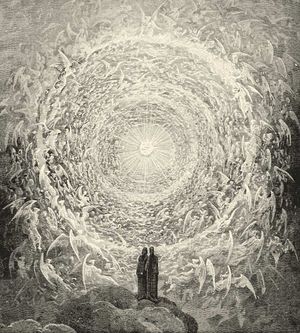 |
|---|---|---|
| Second Sphere (active) |
Dominions • Virtues • Powers |
|
| Third Sphere (active) |
Principalities • Archangels • Angels |
|
